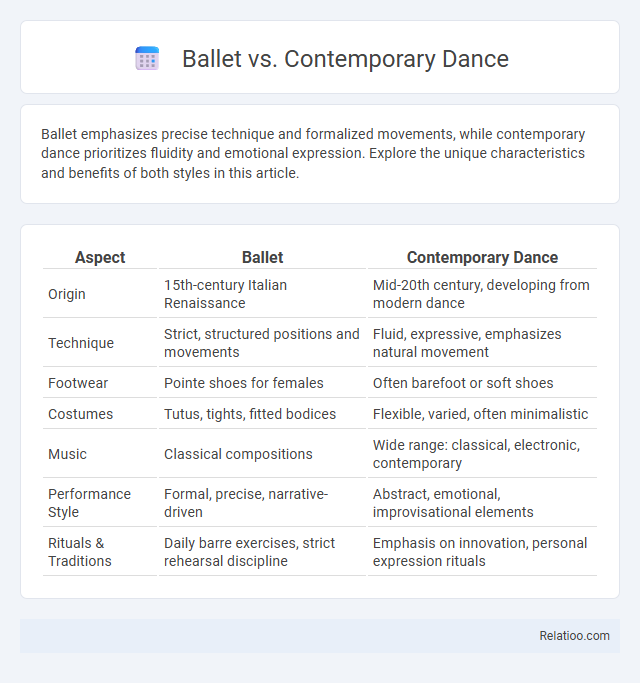Ballet emphasizes precise technique and formalized movements, while contemporary dance prioritizes fluidity and emotional expression. Explore the unique characteristics and benefits of both styles in this article.
Table of Comparison
| Aspect | Ballet | Contemporary Dance |
|---|---|---|
| Origin | 15th-century Italian Renaissance | Mid-20th century, developing from modern dance |
| Technique | Strict, structured positions and movements | Fluid, expressive, emphasizes natural movement |
| Footwear | Pointe shoes for females | Often barefoot or soft shoes |
| Costumes | Tutus, tights, fitted bodices | Flexible, varied, often minimalistic |
| Music | Classical compositions | Wide range: classical, electronic, contemporary |
| Performance Style | Formal, precise, narrative-driven | Abstract, emotional, improvisational elements |
| Rituals & Traditions | Daily barre exercises, strict rehearsal discipline | Emphasis on innovation, personal expression rituals |
Introduction to Ballet and Contemporary Dance
Ballet is a highly structured classical dance form characterized by precise techniques, extended lines, and graceful, fluid movements that emphasize poise and discipline. Contemporary dance blends elements of ballet, modern, and jazz dance, focusing on expression, versatility, and grounded movements that often incorporate floor work and improvisation. Both ballet and contemporary dance serve as foundational styles for dancers, offering distinct approaches to body movement, storytelling, and artistic interpretation.
Historical Origins and Evolution
Ballet originated in the Italian Renaissance courts of the 15th century and evolved into a highly structured performance art in French and Russian theaters, emphasizing precise technique and formalized movements. Contemporary dance emerged in the early 20th century as a reaction against the rigidity of ballet, blending elements from modern, jazz, and classical dance to prioritize expression and fluidity. Your understanding of these dance forms deepens by recognizing ballet's classical foundation, contemporary dance's innovative evolution, and the broader, diverse nature of dance itself as it continues to adapt through cultural shifts.
Key Characteristics and Styles
Ballet is characterized by its precise techniques, formalized movements, and emphasis on posture, balance, and grace, often performed to classical music. Contemporary dance blends elements of various styles, including ballet and modern dance, focusing on fluidity, expression, and improvisation to convey emotions and narratives. Dance as a broad category encompasses diverse cultural and stylistic forms, from structured genres like ballet to more freeform and experimental styles found in contemporary and folk dances.
Technique and Movement Vocabulary
Ballet emphasizes strict technique with precise, formalized movements classified into positions and steps such as plies, arabesques, and pirouettes, focusing on balance, alignment, and extended lines. Contemporary dance incorporates a more fluid and expressive movement vocabulary, blending elements of ballet, modern, and jazz, allowing for grounded, off-center, and often improvisational motion. Dance as a broad category encompasses a wide range of techniques and vocabularies, with each style highlighting unique approaches to rhythm, body use, and spatial awareness.
Music and Choreographic Approaches
Ballet relies on classical music compositions and structured choreography emphasizing precise, flowing movements and formal technique. Contemporary dance incorporates diverse musical genres, from ambient to electronic, allowing for more fluid, expressive choreography that blends improvisation with planned sequences. Your choice between ballet and contemporary will shape how you experience music's influence on movement, ranging from disciplined patterns to spontaneous artistic exploration.
Costumes and Visual Aesthetics
Ballet costumes emphasize structured tutus, pointe shoes, and elegant, form-fitting attire to highlight precise movements and classical lines, creating a graceful and ethereal visual impact. Contemporary dance costumes prioritize fluidity and comfort, often utilizing loose, minimalistic fabrics that allow freedom of movement and reflect the expressive, often unconventional nature of choreography. Dance in general spans diverse styles where costumes vary widely, but visual aesthetics typically serve to complement the narrative, mood, and cultural context of the performance.
Training and Educational Pathways
Ballet training emphasizes rigorous classical techniques and structured progression through established grades and certifications, often beginning in early childhood to develop discipline and strength. Contemporary dance education incorporates diverse movement styles and improvisation, encouraging creativity and personal expression, typically offered in specialized conservatories or university programs. Your choice between ballet, contemporary dance, or combining both should consider the specific training methodologies and educational pathways that align with your artistic goals and career aspirations.
Expressive Intent and Storytelling
Ballet emphasizes precise technique and classical storytelling with defined narratives, often portraying traditional themes through graceful, structured movement. Contemporary dance prioritizes emotional expression and abstract storytelling, using fluid, innovative choreography that allows Your personal interpretation and connection to the performance. Dance as a broader art form encompasses diverse styles, each offering unique methods to convey expressive intent and stories, blending movement, emotion, and cultural context.
Audience Appeal and Cultural Influence
Ballet captivates audiences with its classical technique, elegant form, and rich cultural heritage rooted in European traditions, making it a symbol of grace and discipline. Contemporary dance draws a diverse audience by blending styles and emphasizing emotional expression, reflecting modern cultural influences and social themes. Your appreciation of these dance forms can deepen by recognizing ballet's structured precision, contemporary dance's innovative freedom, and their unique roles in shaping cultural narratives.
Choosing Between Ballet and Contemporary Dance
Choosing between ballet and contemporary dance involves evaluating your personal goals, body type, and artistic preferences. Ballet emphasizes structured technique, discipline, and classical form, which appeals to dancers seeking precision and traditional movements. Contemporary dance offers greater freedom of expression, incorporating diverse styles and improvisation, suitable for those wanting innovation and emotional storytelling through movement.

Infographic: Ballet vs Contemporary Dance
 relatioo.com
relatioo.com